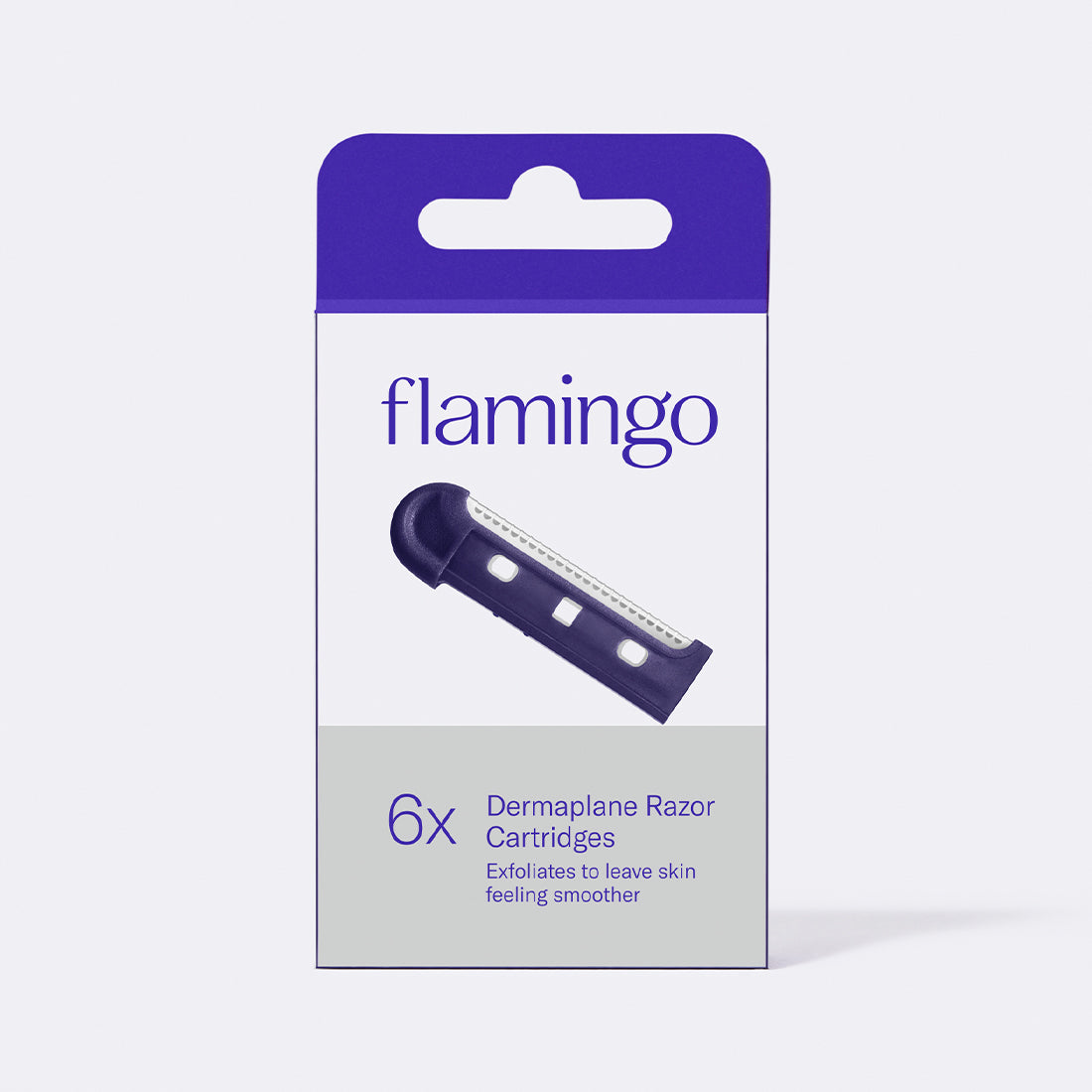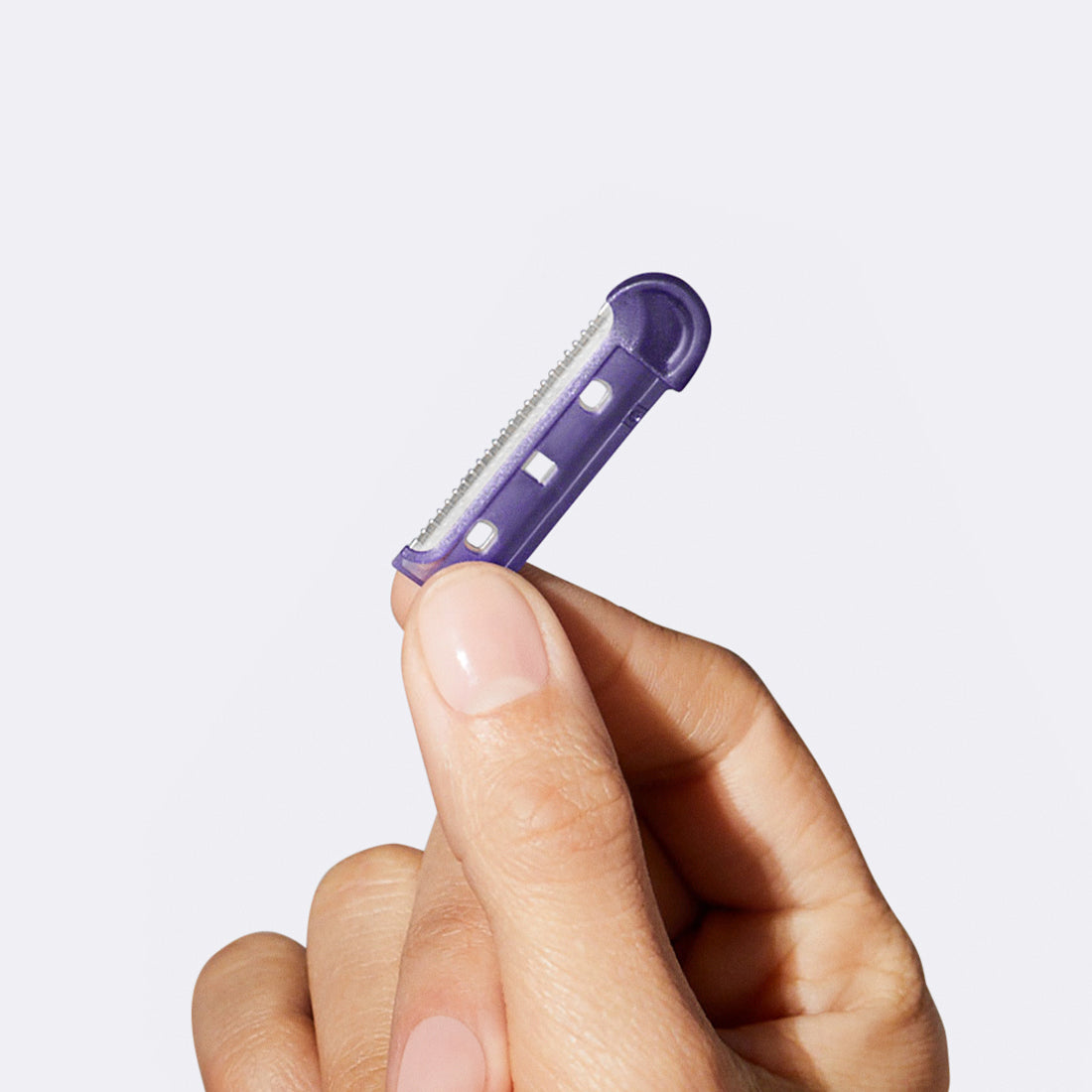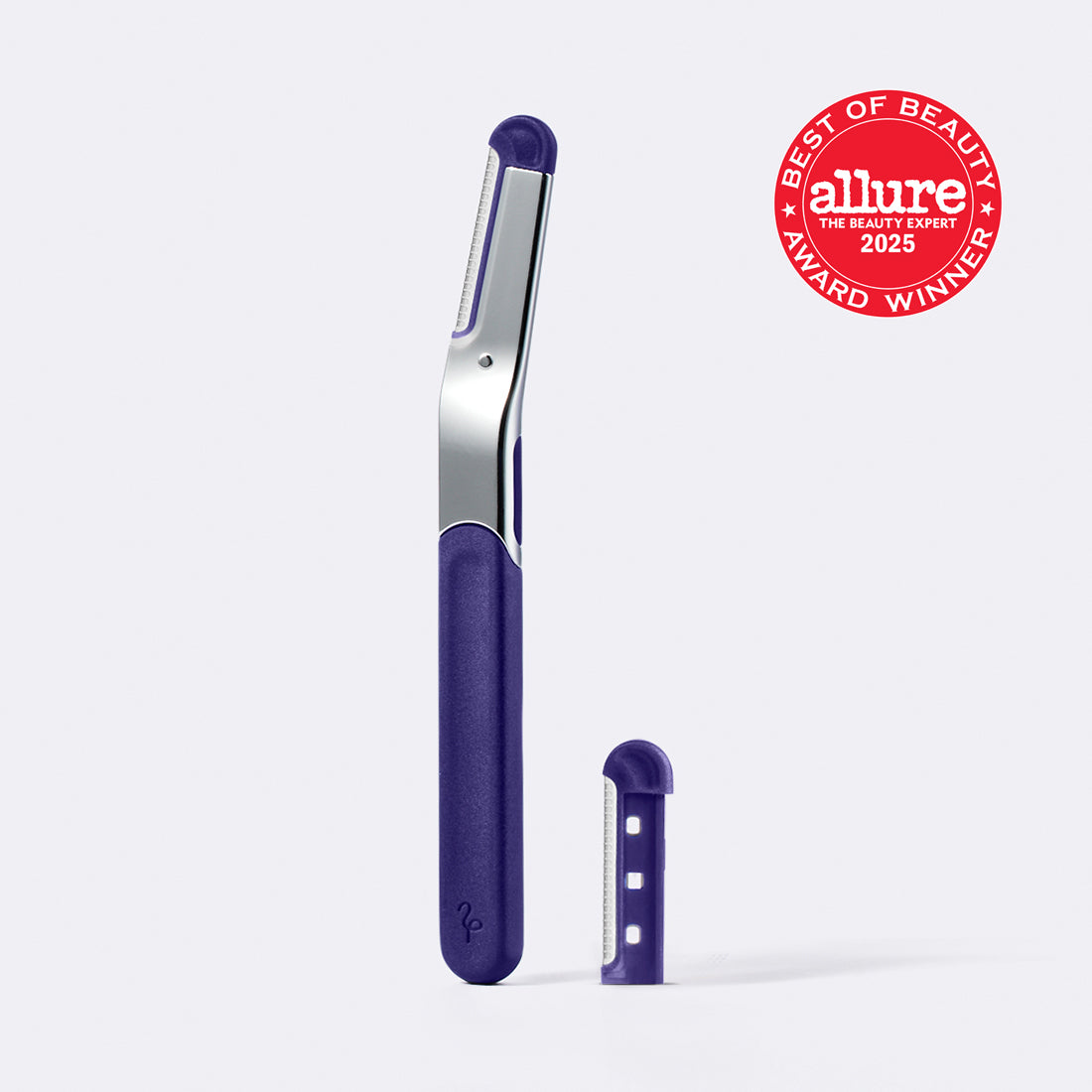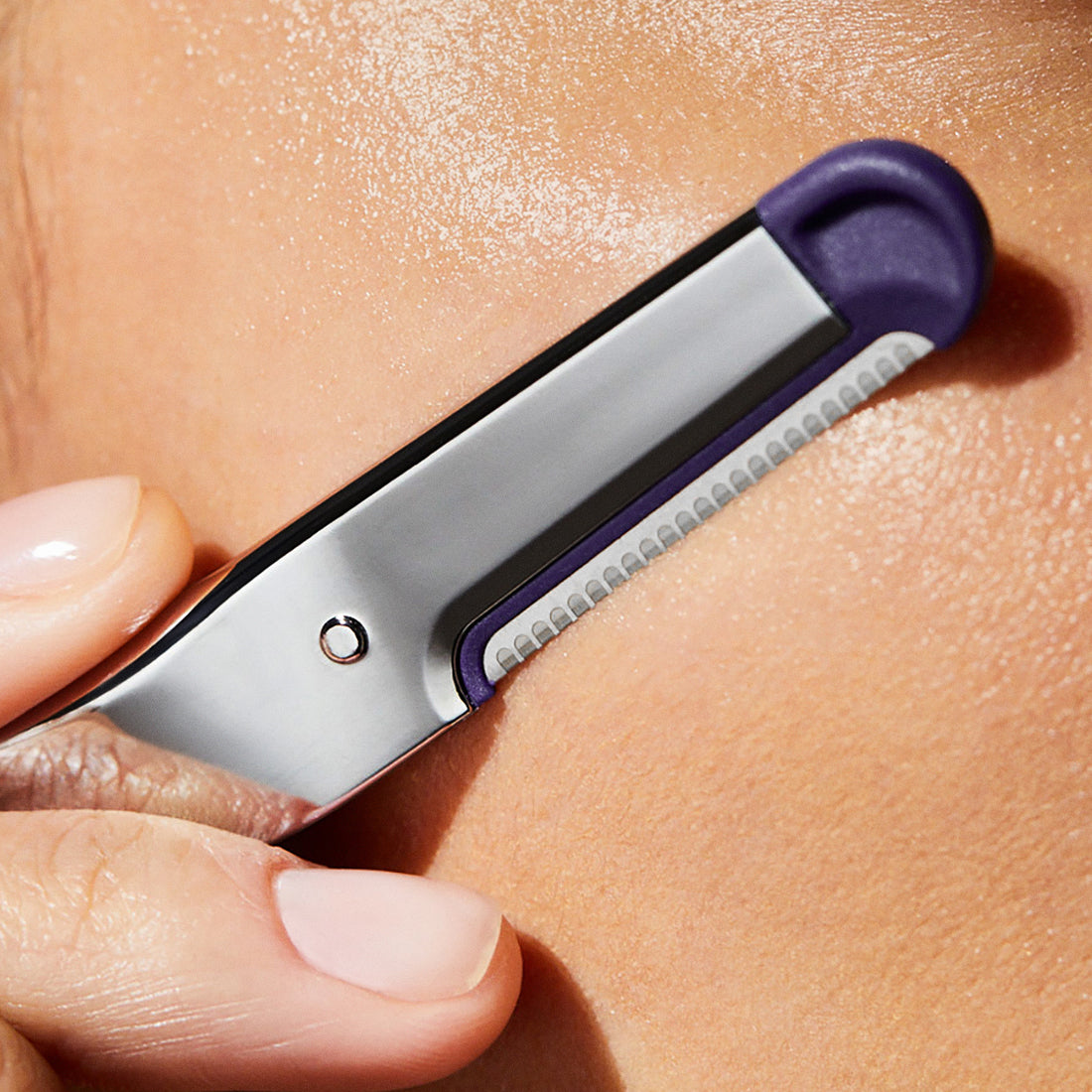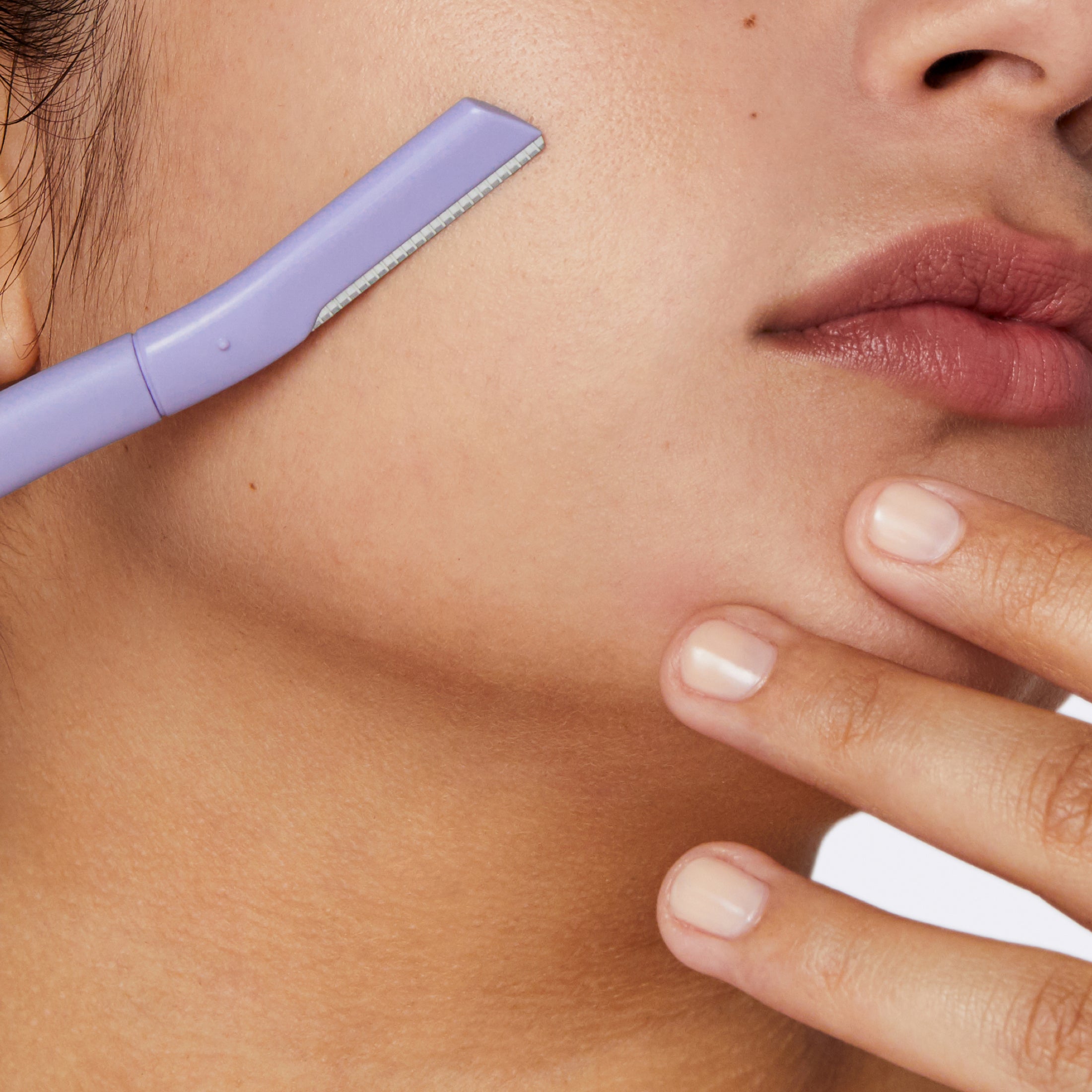DERMAPLANING IS THE SKINCARE CRAZE you’ve probably seen all over your social feeds, but this hair removal method is more than just a trend. Removing facial hair and dead skin with a dermaplane razor, also known as a single blade facial razor, can give you smooth, brighter looking skin and create an even base for makeup application. If you’re intimidated by the idea of putting a razor to your face, don’t worry–we’ve got you covered. As experts in hair removal, we’ve compiled the top tips to make sure you get the best, safest at-home dermaplaning experience.
What is Dermaplaning?
Dermaplaning is the use of a single-blade facial razor to gently exfoliate skin and remove fine hair (a.k.a. peach fuzz) from your face. It’s a popular skincare method because it basically makes your skin smooth and more radiant looking in just a few strokes. Plus, it can create an even base for makeup application and skincare. Think of it like step zero of your skincare routine, since it makes everything that follows a lot more impactful. There are two methods of dermaplaning: professional and at-home. Professional dermaplaning is usually performed by a licensed esthetician using a surgical grade blade. It can be a more intense form of exfoliation than at-home dermaplaning, but is also more costly. At-home dermaplaning is a convenient, affordable method done by using a disposable dermaplane razor yourself.
Benefits of Dermaplaning
- Smoother Skin
Traditional exfoliation uses abrasive methods, like scrubs with small granules or chemical acids that dissolve dead skin, that can sometimes be too harsh on sensitive skin. On the other hand, dermaplaning uses a blade to gently and precisely remove dead skin cells. It also has the added benefit of removing peach fuzz at the same time. This combination of exfoliation and hair removal leaves your skin looking and feeling smoother.
-
Better Skincare Absorption
Dermaplaning can help skincare absorption because it removes dead skin cells and peach fuzz, which act like barriers to your skin. Once they’re removed, your skin can better absorb products and ideally reap the benefits they promise. Though immediately after dermaplaning, you want to let your skin recover first. After dermaplaning, apply a gentle moisturizer, and SPF 30 or higher if the skin will be exposed to the sun. Allow skin to rest for 8 hours before applying makeup, cleansers, exfoliants, or other facial products. Pro tip: dermaplane before bedtime and wake up to skin that is smooth and ready for the rest of your skincare routine!
-
A Smooth Makeup Base
If you’ve ever gotten frustrated with makeup that settles into patches of dry skin or applies unevenly no matter how much skincare prep you’ve done, dermaplaning might be just the solution for you. By removing the texture of peach fuzz and dead skin cells that sit on the top layer of your skin, dermaplaning can help improve the appearance of foundation. Basically, dermaplaning provides a smoother, more even canvas for makeup to sit on.
-
A Fuzz Free Face
Dermaplaning removes peach fuzz a.k.a. vellus hair, the fine, soft hair that covers most of your body. It’s a different kind of hair than the longer, thicker hair you find on your scalp, known as terminal hair. You’ve probably heard that peach fuzz grows back thicker or darker when you remove it, but this is a myth! Rest assured, dermaplaning does not change hair in any permanent way. According to board certified dermatologist Dr. Claire Wolinsky, “Dermaplaning will not cause hair to grow back thicker or darker in any location. The hair can be expected to grow back in the same pattern as before.”
Potential Dermaplaning Side Effects
Most people experience little to no irritation after dermaplaning, but, like all forms of hair removal, it does have potential risks—especially if you don’t follow proper technique or dermaplane on irritated skin. Small cuts can occur if you apply a dermaplane razor with excessive pressure. Temporary heightened sensitivity or redness can occur on dermaplaned areas of your face after shaving (this is why it’s important to let your skin rest for 8 hours and only use gentle skincare immediately after dermaplaning).
Who Shouldn’t Dermaplane?
If your skin is sunburnt, inflamed, or you have acne or rosacea, we don’t recommend dermaplaning. It’s safest to wait until your skin has fully healed. According to board certified dermatologist Dr. Claire Wolinsky, “Dermaplaning is safe for most skin types, however acne prone skin will be likely to experience more inflammation around the hair follicle. Any manipulation of the hair follicle can lead to inflammation and thus cause folliculitis or an acne breakout.” Everyone’s skin is different, so if you’re unsure if dermaplaning is right for you, consult with a dermatologist before you try it out.
How to Dermaplane Safely at Home
-
Assemble Your Tools
-
Dermaplane Razor
-
Gentle facial cleanser
-
Gentle moisturizer
-
Sunscreen with SPF 30+ (if needed)
First and foremost, you’ll need a quality dermaplane razor. You don’t need something as heavy duty as a professional scalpel. For at-home dermaplaning, the best tool is a disposable dermaplane razor or a refillable dermaplane razor with replaceable blades. The Flamingo Disposable Dermaplane Razor and Flamingo Refillable Dermaplane razor are both effective, affordable options.
-
Prep Your Skin
If you’re currently using any exfoliating products or products with active ingredients on your face, like retinols, acids, benzoyl peroxide, or scrubs, stop use for a few days before dermaplaning to help prevent irritation. Once it’s time to dermaplane, thoroughly wash your fash with a gentle cleanser to remove any dirt, oil, or makeup. Pat skin dry using a clean towel.
-
Dermaplane Your Face
Use a dermaplane razor on clean skin, apply light moisturizer as needed for extra comfort. Hold skin taut in the area you are about to dermaplane. Hold dermaplane razor at a level 30° angle and use light, downward strokes in the direction of hair growth. Do not apply excessive pressure. Wipe the blade as you go on a towel or tissue to remove any buildup. Avoid inflamed skin or areas with acne. Take extra precaution around your hairline and eyebrows to avoid removing hair you actually want to keep.
-
Apply Aftercare
After dermaplaning, apply a gentle moisturizer. If you’ll be going outside, also apply a sunscreen that contains SPF 30 or higher. Let skin rest for around 8 hours before continuing to apply skincare that contains active ingredients or exfoliants.
Common Dermaplaning Mistakes to Avoid
-
Using a Dull or Dirty Blade
A dull or dirty dermaplane blade can lead to irritated skin, a higher chance of cuts, and potential breakouts. Dermaplane razor blades should only be used 1 to 3 times before discarding. Flamingo Disposable Dermaplane Razors should only be used once before discarding, while Flamingo Refillable Dermaplane Blades can be used up to 3 times. After use, be sure to wipe the blade using a tissue or clean, dry cloth to remove dead skin.
-
Applying Too Much Pressure
A sharp dermaplane razor blade should do all the hard work for you, so you shouldn’t apply too much pressure. This can lead to an increased risk of cuts and irritation. If you find yourself having to apply a lot of pressure to remove peach fuzz, this is usually a sign your blade has become dull and needs replacing.
-
Dermaplaning Too Frequently
According to board certified dermatologist Dr. Claire Wolinsky, “Dermaplaning when done every 1-4 weeks should be safe for most people’s skin.” This accounts for the skin’s natural cell turnover cycle and prevents you from over-exfoliating your skin, which can lead to irritation and redness.
-
Skipping Aftercare and Sun Protection
Dermaplaning can disrupt the skin’s natural barrier, so it’s important to apply aftercare to encourage healthy recovery. Since it causes your skin to be in a temporarily more sensitive state, it’s especially important to apply SPF if you’re planning on going into the sun after dermaplaning.
Professional Dermaplaning vs. At-Home Dermaplaning
Professional dermaplaning is a non-invasive procedure usually performed by a licensed esthetician. It typically involves using a medical grade scalpel to achieve a deeper level of exfoliation than you could safely do yourself at home. This can create more dramatic and long-lasting results than at-home dermaplaning, but it comes at a cost: professional dermaplaning sessions usually cost between $75 and $250, depending on where you live and the esthetician’s level of experience. If the idea of dermaplaning your own face scares you (though we promise, it’s easier than you think), seeing a professional can be a great alternative.
If you’re comfortable trying out dermaplaning at home, it’s only as expensive as the few dollars it takes to buy a dermaplane razor. And while the exfoliation may not be as deep as you’d achieve with a professional, you still get smooth, more radiant-looking skin that’s free of peach fuzz.
Conclusion
Though at-home dermaplaning might seem intimidating at first, it’s really an easy, effective way to get smooth, radiant-looking skin. Just be sure to take your time and follow proper technique:
-
Always use a sharp, clean dermaplane razor
-
Cleanse skin before dermaplaning
-
Carefully dermaplane in light, downward strokes
-
Do not apply excess pressure
-
Apply gentle moisturizer after dermaplaning, plus SPF 30 if going outside
-
Allow skin to rest for 8 hours before applying skincare with active ingredients or exfoliants
-
Do not dermaplane on inflamed, sunburnt, or acne prone skin
Recommended Products
Flamingo Disposable Dermaplane Razor
Flamingo Refillable Dermaplane Razor
Flamingo Refillable Dermaplane Refills
FAQs
How often should you dermaplane at home?
You should only dermaplane about once or twice a month. Dermaplaning too frequently can irritate your skin.
Will dermaplaning make my facial hair grow back thicker?
No, dermaplaning will not make your facial hair grow back thicker. Dermaplaning removes peach fuzz a.k.a. vellus hair, the fine, soft hair that covers most of your body. It does not change hair in any permanent way and you can expect it to grow back in the same pattern as before.
What are the best skincare products to use post-dermaplaning?
After dermaplaning, it’s important to apply a gentle moisturizer that’s free of active ingredients, as well as sunscreen with SPF 30 or higher, if you’ll be going outside. Let skin rest for 8 hours before applying skincare with active ingredients or exfoliants.
Can dermaplaning help with acne scars and hyperpigmentation?
At-home dermaplaning can give you smoother, more radiant-looking skin, but it’s not necessarily a solution for acne scars and hyperpigmentation. Talk to a dermatologist about solutions for these concerns.
Is dermaplaning safe for all skin types?
Most people can dermaplane, but if your skin is sunburnt, inflamed, or you have acne or rosacea, we don’t recommend dermaplaning. It’s safest to wait until your skin has fully healed.
What’s the difference between dermaplaning and shaving?
Dermaplaning uses a single blade facial razor to remove peach fuzz and dead skin cells, while shaving uses a multi blade razor to remove thicker, terminal hair (i.e. a beard).


